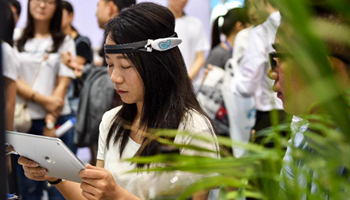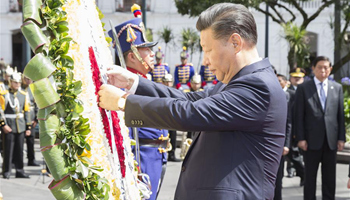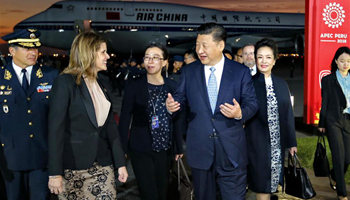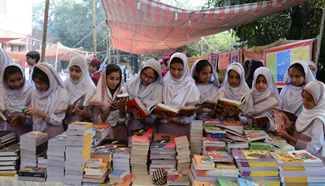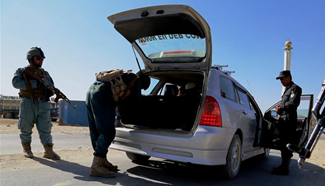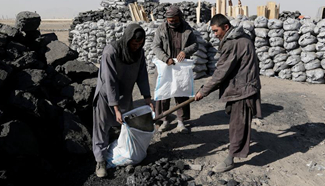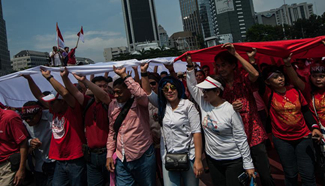
Chinese President Xi Jinping (2nd R, front) and his wife Peng Liyuan (1st R, front) are received by Peruvian Second Vice President Mercedes Araoz (2nd L) at the airport in Lima, Peru, Nov. 18, 2016. Xi arrived in Peru Friday to attend the upcoming Asia-Pacific Economic Cooperation (APEC) Economic Leaders' Meeting and pay his first state visit to Peru. (Xinhua/Ju Peng)
LIMA, Nov. 19 (Xinhua) -- Chinese President Xi Jinping arrived in Peru Friday to attend the upcoming Asia-Pacific Economic Cooperation (APEC) Economic Leaders' Meeting and pay his first state visit to the Latin American country.
Prior to the trip, Xi had visited neighboring Ecuador. The APEC meeting is scheduled for Saturday and Sunday in Peru's capital Lima under the theme of "Quality Growth and Human Development."
"My visit aims to strengthen friendship, expand common grounds, deepen cooperation and promote development," Xi said while delivering a written speech upon arrival at the airport in Lima.
"China supports Peru in hosting the 24th APEC Economic Leaders' Meeting, and I'm looking forward to meeting with Peruvian leaders to have in-depth exchanges of views on bilateral relations and on major international, regional issues of common concern," he said.
NEW MOVES EXPECTED ON FTAAP
In Lima, Xi will deliver a keynote speech at the APEC CEO Summit, hold dialogue with representatives of the APEC Business Advisory Council and meet leaders of some other APEC member economies.
This year's APEC Economic Leaders' Meeting comes as the global economy is still struggling to recover, with flagging trade and investment, rising protectionism and fragmented trade rules.
China, as the world's second largest economy, has called for safeguarding the global free trade system and opposing protectionism in any form.
It also expects the APEC members to reach new consensus and take new action on the Free Trade Area of the Asia-Pacific (FTAAP) at the Lima meeting. The FTAAP process was launched at the 2014 APEC Economic Leaders' Meeting in Beijing and a roadmap was endorsed. A "collective strategic study" on the FTAAP was conducted subsequently, as agreed by the APEC members, and the result should be reported to the economic leaders by the end of 2016.
"China hopes that the Lima meeting can promote openness and inclusiveness, deepen practical cooperation and continue to implement the outcomes of the Beijing meeting," Chinese Vice Foreign Minister Li Baodong has told reporters.
Raul Salazar, APEC affairs director at the Peruvian Foreign Ministry, believes the FTAAP is necessary.
"This step taken in Beijing ... has forced all the members to face the reality that this is necessary for a number of reasons. Peru holds the position that we need an Asia-Pacific free trade area. It would allow for APEC's work to be deepened and would see free trade agreements proliferate," he said.
Founded in 1989, APEC, grouping 21 members, now accounts for 39 percent of the global population, 60 percent of the global economy and 46 percent of the global trade.
Peru previously hosted the APEC Economic Leaders' Meeting in 2008. China, which greets its 25th anniversary of joining the influential forum this year, had also hosted the meeting twice -- in 2001 in Shanghai, and in 2014 in Beijing.
MUTUAL VISIT IN TWO MONTHS
After attending the APEC meeting, Xi will pay his first state visit to Peru, only about two months after his Peruvian counterpart, Pedro Pablo Kuczynski, -- who was sworn in on July 28 -- made his first foreign visit to China.
Xi will hold talks with Kuczynski, meet President of Peruvian Congress Luz Salgado and give a speech at the Congress. The two heads of state are also scheduled to attend the closing ceremony of the China-Latin America and Caribbean 2016 Year of Culture Exchange.
This year marks the 45th anniversary of diplomatic ties between the two countries, which have witnessed long-term friendly relations and wide-ranging cooperation.
The two countries upgraded their ties to a comprehensive strategic partnership in 2013, and signed a bilateral free trade agreement as early as in April 2009, which took effect on March 1, 2010.
China is now Peru's biggest trade partner, export market and source of imports in the world, while Peru is China's sixth largest trade partner in Latin America.
Two-way trade between the two countries reached about 7.2 billion U.S. dollars in the first half of this year, up 10.7 percent year on year, according to Chinese official statistics.
Both China and Peru are ancient civilizations and the two peoples have enjoyed a profound traditional friendship. The two countries have maintained close cultural and educational exchanges. To date, four Confucius Institutes have been established in Peru.
Chinese Ambassador to Peru, Jia Guide, said that both China and Peru are important emerging economies and they are highly complementary on economic front.
"We should make full use of the complementary advantages to strengthen strategic cooperation, vigorously promote investment and upgrade the free trade agreement. We should build our cooperation into a model for emerging economies and for South-South cooperation," Jia said.
To 71-year-old Luis Raul, a Peruvian auto parts dealer who is married to a Chinese woman, President Xi's visit is like a relative coming to his home.
"The visit will bring our two countries even closer. We Peruvian people will receive President Xi with the utmost cordiality, and we will receive Chinese people with open arms!" he said.
THRIVING CHINA-LATIN AMERICA TIES
After Peru, Xi will travel to Chile, the final stop of his current three-nation tour of Latin America.
It is Xi's third visit to Latin America as president since he took office in 2013.
When addressing the Peruvian Congress, Xi is expected to expound on the thriving momentum of the comprehensive cooperative partnership China has forged with Latin America and the Caribbean, and make new proposals on propelling their cooperation.
An intergovernmental forum, known as the China-CELAC Forum, was set up on July 17, 2014 during President Xi's second LatAm visit to steer cooperation between China and the 33-member Community of Latin American and Caribbean States (CELAC).
Chinese official statistics show that the trade volume between China and Latin America rose more than 20-fold during the past decade to reach 236.5 billion dollars in 2015.
Currently, China is the second largest trade partner and third largest investment source country of Latin America, while Latin America is China's seventh largest trade partner.
Xi's state visits to Ecuador, Peru and Chile show that China is keen to further strengthen ties with Latin America, Venezuelan political analyst Vladimir Adrianza said.
China represents both an "excellent" development model for regional countries and an attractive incentive, said Adrianza, who teaches at the Bolivarian Military University of Venezuela in Caracas.
"A growing China-Latin America relationship can help promote multilateral and global development," he said.






